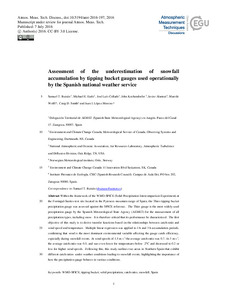Por favor, use este identificador para citar o enlazar este ítem:
http://hdl.handle.net/20.500.11765/7542
Assessment of snowfall accumulation underestimation by tipping bucket gauges in the Spanish operational network [Discussion paper]
| Título : | Assessment of snowfall accumulation underestimation by tipping bucket gauges in the Spanish operational network [Discussion paper] |
| Autor : | Buisán Sanz, Samuel Tomás



|
| Palabras clave : | WMO-SPICE; Tipping bucket; Solid precipitation; Snowfall; Catch ratio |
| Fecha de publicación : | 2016 |
| Editor: | European Geosciences Union |
| Citación : | Atmospheric Measurement Techniques Discussions. 2016, p. 1-22 |
| Versión del editor: | https://dx.doi.org/10.5194/amt-2016-197 |
| Resumen : | Within the framework of the WMO-SPICE (Solid Precipitation Intercomparison Experiment) at the Formigal-Sarrios test site located in the Pyrenees mountain range of Spain, the Thies tipping bucket precipitation gauge was assessed against the SPICE reference. The Thies gauge is the most widely-used precipitation gauge by the Spanish Meteorological State Agency (AEMET) for the measurement of all precipitation types, including snow. It is therefore critical that its performance be characterized. The first objective of this study is to derive transfer functions based on the relationships between catch ratio and wind speed and temperature. Multiple linear regression was applied to 1 h and 3 h accumulation periods, confirming that wind is the most dominant environmental variable affecting the gauge catch efficiency, especially during snowfall events. At wind speeds of 1.5 m s-1 the average catch ratio was 0.7. At 3 m s-1 , the average catch ratio was 0.5, and was even lower for temperatures below -2ºC and decreased to 0.2 or less for higher wind speeds. Following this, this study outlines two areas in Northern Spain that exhibit different catch ratios under weather conditions leading to snowfall events, highlighting the importance of how the precipitation gauge behaves in various conditions. |
| URI : | http://hdl.handle.net/20.500.11765/7542 |
| ISSN : | 1867-8610 |
| Colecciones: | Artículos científicos 2015-2018 |
Ficheros en este ítem:
| Fichero | Descripción | Tamaño | Formato | ||
|---|---|---|---|---|---|
| amt-2016-197.pdf | 1,3 MB | Adobe PDF |  Visualizar/Abrir |
Los ítems de Arcimis están protegidos por una Licencia Creative Commons, salvo que se indique lo contrario.





